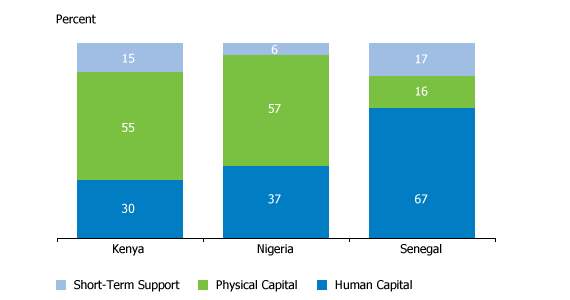
Remittances From Sub-Saharan African Migrants Pay for Schooling, Health Care
(November 2012) Most of the money migrant workers send home to sub-Saharan Africa is spent on education, health care, buying land, building houses, starting business or improving farms, according to recent surveys.1
In Senegal, for example, more than half is spent on food, education, and health care (human capital). In Kenya and Nigeria, investments such as homebuilding, land purchases, and farm improvements (physical capital) account for more than half of the spending (see figure).
Use of Remittances by Recipient Households in Kenya, Nigeria, and Senegal

Source: Dilip Ratha, Leveraging Migration for Africa: Remittances, Skills, and Investments (Washington, DC: The World Bank, 2011).
Countries’ economic growth can be directly affected by these remittances through increased consumption and investment. In turn, increased spending on health, education, and nutrition can contribute to long-term well-being and productivity for people and households. In many low- and middle-income countries worldwide, remittances make up a sizeable share of the gross domestic product (GDP), accounting for as much as 30 percent in some cases. For Senegal, remittances account for 11 percent of the GDP, and in Kenya and Nigeria, 5 percent each.2
Household surveys conducted as part of the World Bank’s Africa Migration Project tracked migration and remittances in 2009 from five African countries: Burkina Faso, Kenya, Nigeria, Senegal, and Uganda. Together with data from the 2005-06 Ghana Living Standard Measurement Survey, researchers examined the impact of this money.3
A Little Money Can Go a Long Way
In 2010, remittances to Africa reached $40 billion, or 2.6 percent of Africa’s GDP in 2009.4 Remittances sent by workers in countries outside Africa are much higher than those sent from within Africa or domestically within countries. However, the surveys show wide variation in the amounts received among the surveyed countries—from about US$750 annually per household in Burkina Faso to US$3,000 or more in Kenya and Senegal. The survey analysis also points out that more than half the households in Burkina Faso, Ghana, and Nigeria receiving remittances from outside Africa are in the wealthiest 40 percent of the population.
Gender Differences in Decisionmaking and Spending
Young men are most likely to migrate, and the majority of international migrants—both within and outside Africa—are male. When men migrate, women may be empowered to take on more household decisionmaking responsibility and control of their own income. A woman may also be the person designated to receive and manage remittances.
In Ghana, 52 percent of households with migrants living outside Africa are female-headed, compared with 25 percent in households with no migrants. In Senegal, female-headed households jump from 8 percent with no migrants to 48 percent with international migrants.5
Households headed by women tend to spend more on health and education, which can increase human capital in the long term, while households headed by men tend to use the resources for savings and investments or other income-generating projects.6
Impact on Health
Remittances can contribute to better health by enabling household members to purchase more food and access better health care services. Remittances have also been shown to complement foreign health aid in poor countries and provide greater access to health care. In 56 developing countries, higher remittances per capita were found to be associated with the use of private treatment for fever and diarrhea.7
Education and Access to Information
Findings from the surveys suggest that remittances may help increase the resources devoted to education. Among households in Nigeria and Uganda that receive remittances from outside Africa, the number of household members with a secondary education is twice as high as households receiving no remittances and is nearly three times as high for education beyond high school. Education ranks as the second-highest use of remittances from outside Africa in households in Nigeria and Uganda.
Survey findings reveal that remittances can help provide access to information and communication technology. In Burkina Faso, 66 percent of households that receive remittances from outside Africa have access to a mobile phone, compared with 41 percent of nonrecipients. This pattern also holds for televisions (41 percent vs. 9 percent) and computers (14 percent vs. 2 percent).
Insurance Against Adverse Shocks
Remittances are often a crucial source of income, ensuring the survival of many poor households.8 Remittances allow households to better withstand unexpected losses of income or threats to livelihood such as drought, famine, or other natural disasters.
Remittances are often used to make improvements to property, allowing for more sturdy construction. Surveys found that in both Burkina Faso and Ghana, when similar households are compared, those receiving remittances from outside Africa were more likely to live in concrete houses than those receiving no remittances. Among those receiving remittances in Ghana, 77 percent have concrete homes, vs. 68 percent for those who receive no remittances.
Donna Clifton is a communications specialist in International Programs at the Population Reference Bureau.
References
- Dilip Ratha, Leveraging Migration for Africa: Remittances, Skills, and Investments (Washington, DC: The World Bank, 2011).
- World Bank staff calculation based on data from International Monetary Fund, Balance of Payments Statistics Yearbook 2011, and data releases from central banks, national statistical agencies, and World Bank country desks, accessed at http://siteresources.worldbank.org/INTPROSPECTS/Resources/334934-1110315015165/RemittancesData_Inflows_Apr12(Public).xlsx.
- Ratha, Leveraging Migration for Africa.
- Ratha, Leveraging Migration for Africa.
- Sonia Plaza, Mario Navarrete, and Dilip Ratha, Migration and Remittances Household Surveys in Sub-Saharan Africa: Methodological Aspects and Main Findings (Washington, DC: The World Bank, 2011).
- Rosalia Cortes, Remittances and Children’s Rights: An Overview of Academic and Policy Literature (New York: UNICEF, 2007).
- Ratha, Leveraging Migration for Africa.
- Cortes, Remittances and Children’s Rights.
